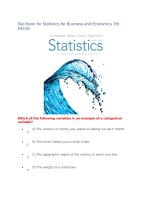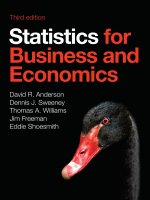Statistics for business economics 7th by paul newbold chapter 08
Bạn đang xem bản rút gọn của tài liệu. Xem và tải ngay bản đầy đủ của tài liệu tại đây (191.27 KB, 46 trang )
Statistics for
Business and Economics
7th Edition
Chapter 8
Estimation: Additional Topics
Copyright © 2010 Pearson Education, Inc. Publishing as Prentice Hall
Ch. 8-1
Chapter Goals
After completing this chapter, you should be able to:
Form confidence intervals for the difference between
two means from dependent samples
Form confidence intervals for the difference between
two independent population means (standard deviations
known or unknown)
Compute confidence interval limits for the difference
between two independent population proportions
Determine the required sample size to estimate a mean
or proportion within a specified margin of error
Copyright © 2010 Pearson Education, Inc. Publishing as Prentice Hall
Ch. 8-2
Estimation: Additional Topics
Chapter Topics
Confidence Intervals
Population
Means,
Dependent
Samples
Population
Means,
Independent
Samples
Population
Proportions
Examples:
Same group
before vs. after
treatment
Group 1 vs.
independent
Group 2
Copyright © 2010 Pearson Education, Inc. Publishing as Prentice Hall
Proportion 1 vs.
Proportion 2
Sample Size
Determination
Large
Populations
Finite
Populations
Ch. 8-3
8.1
Dependent Samples
Tests Means of 2 Related Populations
Dependent
samples
Paired or matched samples
Repeated measures (before/after)
Use difference between paired values:
di = x i - y i
Eliminates Variation Among Subjects
Assumptions:
Both Populations Are Normally Distributed
Copyright © 2010 Pearson Education, Inc. Publishing as Prentice Hall
Ch. 8-4
Mean Difference
The ith paired difference is di , where
Dependent
samples
di = x i - y i
The point estimate for
the population mean
paired difference is d :
The sample
standard
deviation is:
n
d=
∑d
i =1
i
n
n
Sd =
2
(d
−
d
)
∑ i
i=1
n −1
n is the number of matched pairs in the sample
Copyright © 2010 Pearson Education, Inc. Publishing as Prentice Hall
Ch. 8-5
Confidence Interval for
Mean Difference
Dependent
samples
The confidence interval for difference
between population means, μd , is
d − t n−1,α/2
Sd
Sd
< μd < d + t n−1,α/2
n
n
Where
n = the sample size
(number of matched pairs in the paired sample)
Copyright © 2010 Pearson Education, Inc. Publishing as Prentice Hall
Ch. 8-6
Confidence Interval for
Mean Difference
(continued)
Dependent
samples
The margin of error is
ME = t n−1,α/2
sd
n
tn-1,α/2 is the value from the Student’s t
distribution with (n – 1) degrees of freedom
for which
α
P(t n−1 > t n−1,α/2 ) =
2
Copyright © 2010 Pearson Education, Inc. Publishing as Prentice Hall
Ch. 8-7
Paired Samples Example
Six people sign up for a
weight loss program. You
collect the following data:
Dependent
samples
Person
1
2
3
4
5
6
Weight:
Before (x)
After (y)
136
205
157
138
175
166
125
195
150
140
165
160
Copyright © 2010 Pearson Education, Inc. Publishing as Prentice Hall
Difference, di
11
10
7
-2
10
6
42
Σ di
d = n
= 7.0
Sd =
2
(d
−
d
)
∑ i
n −1
= 4.82
Ch. 8-8
Paired Samples Example
(continued)
Dependent
samples
For a 95% confidence level, the appropriate t value is
tn-1,α/2 = t5,.025 = 2.571
The 95% confidence interval for the difference between
means, μd , is
d − t n−1,α/2
7 − (2.571)
Sd
S
< μd < d + t n−1,α/2 d
n
n
4.82
4.82
< μd < 7 + (2.571)
6
6
− 1.94 < μd < 12.06
Since this interval contains zero, we cannot be 95% confident, given this
limited data, that the weight loss program helps people lose weight
Copyright © 2010 Pearson Education, Inc. Publishing as Prentice Hall
Ch. 8-9
Difference Between Two Means:
Independent Samples
8.2
Population means,
independent
samples
Different data sources
Unrelated
Independent
Goal: Form a confidence interval
for the difference between two
population means, μx – μy
Sample selected from one population has no effect on the
sample selected from the other population
The point estimate is the difference between the two
sample means:
x–y
Copyright © 2010 Pearson Education, Inc. Publishing as Prentice Hall
Ch. 8-10
Difference Between Two Means:
Independent Samples
(continued)
Population means,
independent
samples
σx2 and σy2 known
Confidence interval uses zα/2
σx2 and σy2 unknown
σx2 and σy2
assumed equal
σx2 and σy2
assumed unequal
Copyright © 2010 Pearson Education, Inc. Publishing as Prentice Hall
Confidence interval uses a value
from the Student’s t distribution
Ch. 8-11
σx2 and σy2 Known
Population means,
independent
samples
σx2 and σy2 known
Assumptions:
*
σx2 and σy2 unknown
Samples are randomly and
independently drawn
both population distributions
are normal
Population variances are
known
Copyright © 2010 Pearson Education, Inc. Publishing as Prentice Hall
Ch. 8-12
σx2 and σy2 Known
(continued)
When σx and σy are known and
both populations are normal, the
variance of X – Y is
Population means,
independent
samples
2
σx2 and σy2 known
σx2 and σy2 unknown
*
σ 2X − Y
2
σy
σx
=
+
nx
ny
…and the random variable
Z=
(x − y) − (μX − μY )
2
σ 2x σ y
+
nX nY
has a standard normal distribution
Copyright © 2010 Pearson Education, Inc. Publishing as Prentice Hall
Ch. 8-13
Confidence Interval,
σx2 and σy2 Known
Population means,
independent
samples
σx2 and σy2 known
*
The confidence interval for
μx – μy is:
σx2 and σy2 unknown
(x − y) − z α/2
σ 2X σ 2Y
σ 2X σ 2Y
+
< μX − μY < (x − y) + z α/2
+
nx ny
nx ny
Copyright © 2010 Pearson Education, Inc. Publishing as Prentice Hall
Ch. 8-14
σx2 and σy2 Unknown,
Assumed Equal
Assumptions:
Population means,
independent
samples
Samples are randomly and
independently drawn
σx2 and σy2 known
Populations are normally
distributed
σx2 and σy2 unknown
σx2 and σy2
assumed equal
*
Population variances are
unknown but assumed equal
σx2 and σy2
assumed unequal
Copyright © 2010 Pearson Education, Inc. Publishing as Prentice Hall
Ch. 8-15
σx2 and σy2 Unknown,
Assumed Equal
(continued)
Forming interval
estimates:
Population means,
independent
samples
The population variances
are assumed equal, so use
the two sample standard
deviations and pool them to
estimate σ
σx2 and σy2 known
σx2 and σy2 unknown
σx2 and σy2
assumed equal
*
σx2 and σy2
assumed unequal
Copyright © 2010 Pearson Education, Inc. Publishing as Prentice Hall
use a t value with
(nx + ny – 2) degrees of
freedom
Ch. 8-16
σx2 and σy2 Unknown,
Assumed Equal
(continued)
Population means,
independent
samples
The pooled variance is
σx and σ known
2
2
y
σx2 and σy2 unknown
σx2 and σy2
assumed equal
*
sp2 =
(n x − 1)s 2x + (n y − 1)s2y
nx + ny − 2
σx2 and σy2
assumed unequal
Copyright © 2010 Pearson Education, Inc. Publishing as Prentice Hall
Ch. 8-17
Confidence Interval,
σx2 and σy2 Unknown, Equal
σx2 and σy2 unknown
σx2 and σy2
assumed equal
*
The confidence interval for
μ1 – μ2 is:
sp2
sp2
σx2 and σy2
assumed unequal
(x − y) − t nx +n y −2,α/2
Where
sp2 =
sp2
nx
+
ny
< μX − μY < (x − y) + t nx +n y −2,α/2
nx
+
sp2
ny
(n x − 1)s 2x + (n y − 1)s2y
nx + ny − 2
Copyright © 2010 Pearson Education, Inc. Publishing as Prentice Hall
Ch. 8-18
Pooled Variance Example
You are testing two computer processors for speed.
Form a confidence interval for the difference in CPU
speed. You collect the following speed data (in Mhz):
CPUx
Number Tested
17
Sample mean
3004
Sample std dev
74
CPUy
14
2538
56
Assume both populations are
normal with equal variances,
and use 95% confidence
Copyright © 2010 Pearson Education, Inc. Publishing as Prentice Hall
Ch. 8-19
Calculating the Pooled Variance
The pooled variance is:
2
2
(
)
(
)
n
−
1
S
+
n
−
1
S
(
17 − 1) 74 2 + (14 − 1) 56 2
x
x
y
y
2
S =
=
p
(n x − 1) + (n y − 1)
(17 - 1) + (14 − 1)
= 4427.03
The t value for a 95% confidence interval is:
t n x +ny −2 , α/2 = t 29 , 0.025 = 2.045
Copyright © 2010 Pearson Education, Inc. Publishing as Prentice Hall
Ch. 8-20
Calculating the Confidence Limits
The 95% confidence interval is
(x − y) − t n x +n y −2,α/2
(3004 − 2538) − (2.054)
sp2
nx
+
sp2
ny
< μX − μY < (x − y) + t n x +ny −2,α/2
sp2
nx
+
sp2
ny
4427.03 4427.03
4427.03 4427.03
+
< μX − μY < (3004 − 2538) + (2.054)
+
17
14
17
14
416.69 < μX − μY < 515.31
We are 95% confident that the mean difference in
CPU speed is between 416.69 and 515.31 Mhz.
Copyright © 2010 Pearson Education, Inc. Publishing as Prentice Hall
Ch. 8-21
σx2 and σy2 Unknown,
Assumed Unequal
Assumptions:
Population means,
independent
samples
Samples are randomly and
independently drawn
σx2 and σy2 known
Populations are normally
distributed
σx2 and σy2 unknown
Population variances are
unknown and assumed
unequal
σx2 and σy2
assumed equal
σx2 and σy2
assumed unequal
*
Copyright © 2010 Pearson Education, Inc. Publishing as Prentice Hall
Ch. 8-22
σx2 and σy2 Unknown,
Assumed Unequal
(continued)
Forming interval estimates:
Population means,
independent
samples
The population variances are
assumed unequal, so a pooled
variance is not appropriate
σx2 and σy2 known
use a t value with ν degrees
of freedom, where
σx2 and σy2 unknown
2
σx2 and σy2
assumed equal
σx2 and σy2
assumed unequal
*
Copyright © 2010 Pearson Education, Inc. Publishing as Prentice Hall
s 2x
s 2y
( ) + ( )
n y
n x
v=
2
2
2
2
s
sx
/(n x − 1) + y /(n y − 1)
n
nx
y
Ch. 8-23
Confidence Interval,
σx2 and σy2 Unknown, Unequal
σx2 and σy2 unknown
σx2 and σy2
assumed equal
σx2 and σy2
assumed unequal
(x − y) − tν ,α/2
*
The confidence interval for
μ1 – μ2 is:
2
2
s 2x s y
s2x s y
+
< μX − μY < (x − y) + tν ,α/2
+
nx ny
nx ny
Where
Copyright © 2010 Pearson Education, Inc. Publishing as Prentice Hall
v=
s 2x
s 2y
( ) + ( )
n y
n x
2
2
2
s2
s 2x
/(n x − 1) + y /(n y − 1)
n
nx
y
Ch. 8-24
8.3
Population
proportions
Two Population Proportions
Goal: Form a confidence interval for
the difference between two
population proportions, Px – Py
Assumptions:
Both sample sizes are large (generally at
least 40 observations in each sample)
The point estimate for
the difference is
Copyright © 2010 Pearson Education, Inc. Publishing as Prentice Hall
pˆ x − pˆ y
Ch. 8-25









